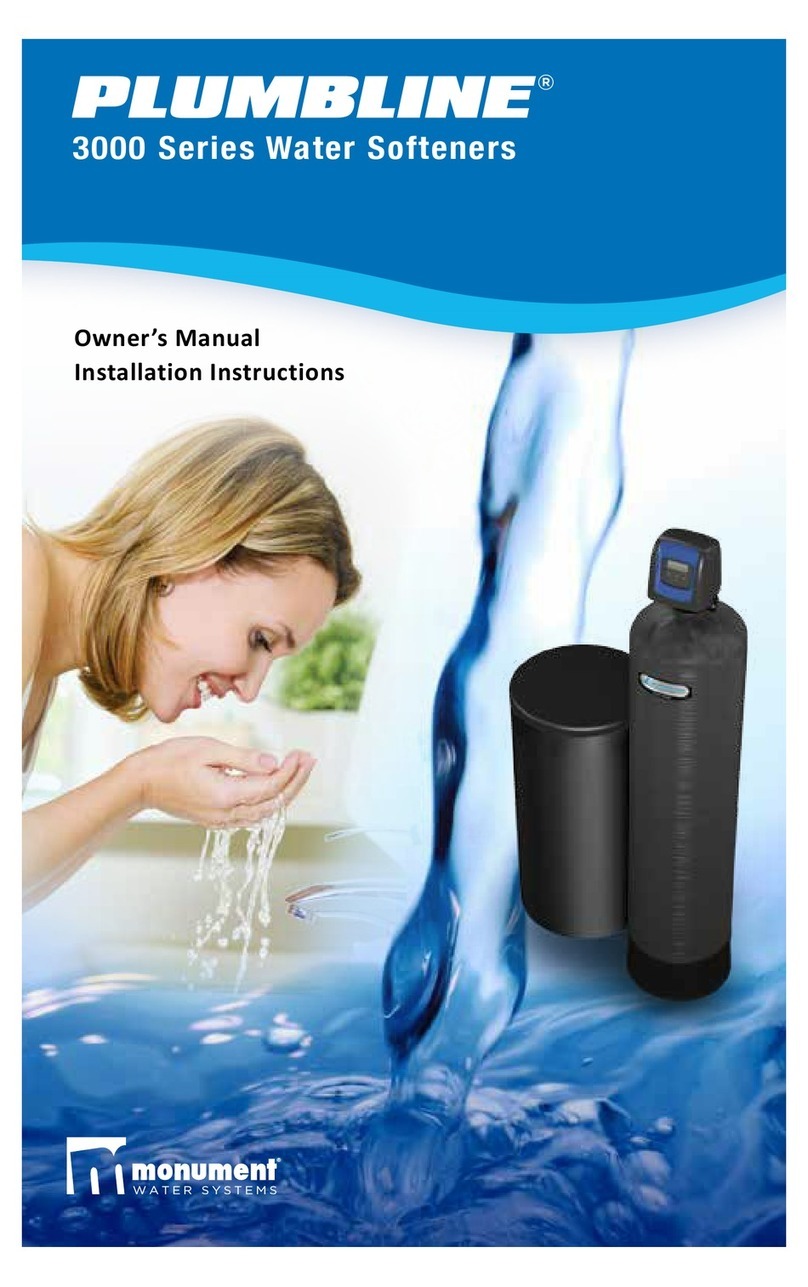
Plumbline Water Softeners Owners Manual
Rev. 08/2011 Page 4 Product No. 13788B
Take special precautions with automatic dishwashers.
Soft water, when combined with caustic phosphates in some dishwasher
detergents and very high temperatures in the dry cycle, can etch dishes and
glassware. To prevent this possibility:
• use the “no heat” dry cycle on your
dishwasher;
• use the minimum amount of a good quality,
low phosphate dishwasher detergent
needed to clean your dishes. This may be
as little as 20 percent of the amount
recommended by the appliance
manufacturer or on the dishwasher soap
box;
• wash good china and crystal by hand.
Special care for plants and fish.
Depending on your water hardness level, amount of rainfall and how often you
water, you could use soft water for outside watering, but why waste your soft
water? Water your lawn, shrubs and outside
plants from an outside hard water faucet, or put
your Plumbline water system in by-pass before
watering. See “By-pass” on page 12 for
instructions on by-passing your system. Many
houseplants can be watered with soft water,
although some can be highly sensitive to the
elevated level of sodium ions in soft water. You
may prefer to water houseplants with hard water
or water from a Plumbline reverse osmosis
system.
Fish accustomed to hard water may have trouble with an abrupt change to soft
water. Make the change gradually over a period of seven to 14 days by blending
hard and soft water until the tank contains 100 percent soft water. Once you
begin using soft water, you should notice that your fish tank stays cleaner longer.
Plumbline Water Softeners Owners Manual
Rev. 08/2011 Page 9 Product No. 13788B
Plumbline Softener Troubleshooting
Problem Possible Causes Solutions
Softener fails to regenerate.
. Electrical service to unit has
been interrupted.
B. Timer is defective.
. Power failure.
A. Assure permanent electrical
service (check fuse, plug, pull
chain or switch).
B. Replace timer.
C. Reset time of day.
Softener delivers hard
water.
. By-pass valve is open.
B. No salt in brine tank.
. Injectors or screen is plugged.
D. Insufficient water flowing into
brine tank.
E. Hot water tank hardness.
F. Leak at distributor tube.
G. Internal valve leak.
A. Close by-pass valve.
B. Add salt to brine tank and
maintain salt level above water
level.
C. Replace injectors and screen.
D. Check brine tank fill time and
clean brine line flow control if
plugged.
E. Repeated flushing of the hot
water tank is required.
F. Make sure distributor tube is
not cracked. Check O-ring and
tube pilot.
G. Replace seals and spacers
and/or piston.
Unit uses too much salt.
. Improper salt setting.
B. Excess water in brine tank.
A. Check salt usage and salt
setting.
B. See excessive water in brine
tank.
Loss of water pressure.
. Iron buildup in line to water
softener.
B. Iron buildup in water softener.
. Inlet control plugged due to
foreign material loose from
pipes by recent work done on
plumbing system.
A. Clean line to water filter.
B. Clean control and add media
cleaner to media bed.
Increase frequency of
regeneration.
C. Remove piston and clean
control.
Loss of media through
drain line.
. Air in water system. A. Assure that well system has
proper air elimination control.
Check for dry well condition.
Iron in conditioned water.
. Fouled media bed. A. Check backwash, brine draw
and brine tank fill, increase
frequency of regeneration,
increase backwash time.
Excessive water in brine
tank.
. Plugged drain line flow control. A. Clean flow control.
Salt water in service line.
. Plugged injector system.
B. Timer not cycling.
. Foreign material in brine valve.
D. Foreign material in brine line
flow control.
A. Clean injector and replace
screen.
B. Replace timer.
C. Clean or replace brine valve.
D. Clean brine line flow control.
Softener fails to draw brine.
. Draw line flow control is
plugged.
B. Injector is plugged.
. Injector screen plugged.
D. Line pressure is too low.
E. Internal control leak.
A. Clean drain line flow control.
B. Clean or replace injectors.
C. Replace screen.
D. Increase line pressure
(minimum 20 psi).
E. Change seals, spacers and/or


























